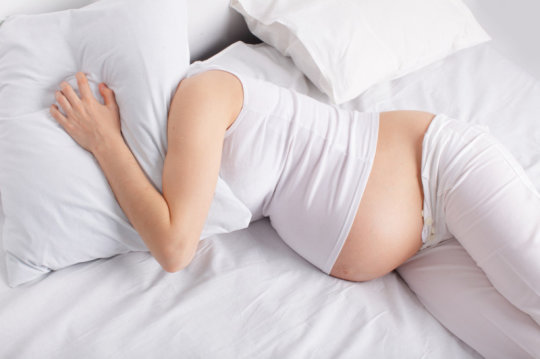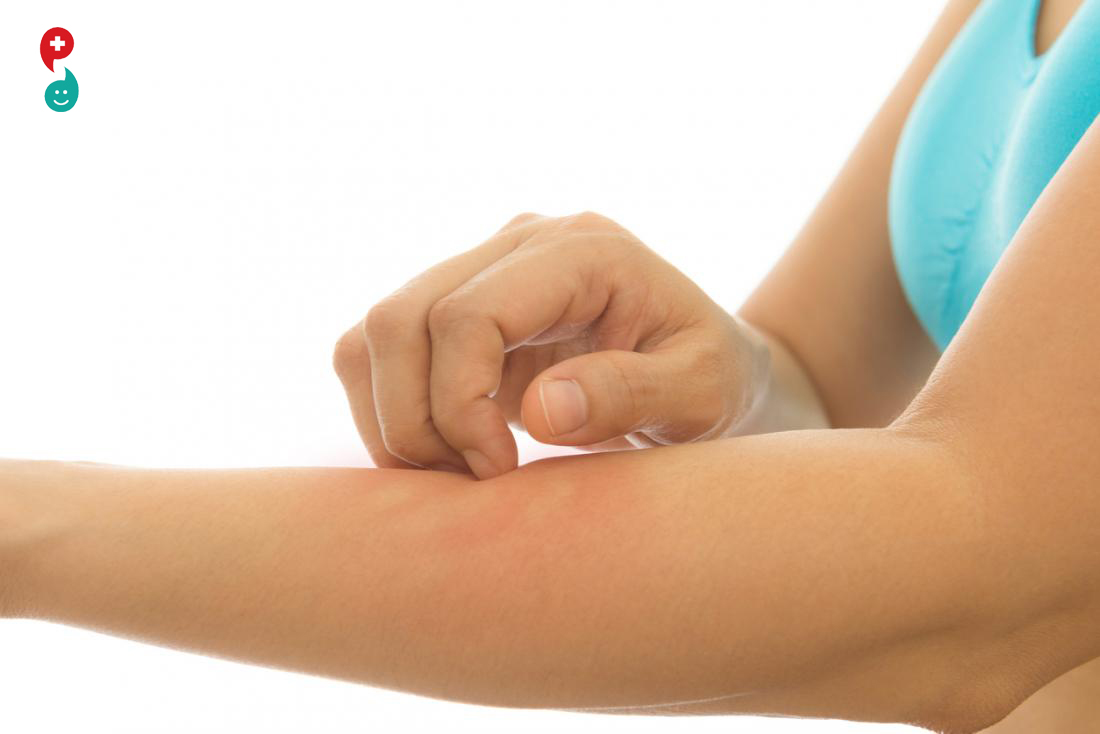Overview
Atopic dermatitis (eczema) is a condition that makes your skin red and itchy. It's common in children but can occur at any age. Atopic dermatitis is long lasting (chronic) and tends to flare periodically. It may be accompanied by asthma or hay fever.
No cure has been found for atopic dermatitis. But treatments and self-care measures can relieve itching and prevent new outbreaks. For example, it helps to avoid harsh soaps, moisturize your skin regularly, and apply medicated creams or ointments.
Symptoms
Atopic dermatitis (eczema) signs and symptoms vary widely from person to person and include:
Dry skin
Itching, which may be severe, especially at night
Red to brownish-gray patches, especially on the hands, feet, ankles, wrists, neck, upper chest, eyelids, inside the bend of the elbows and knees, and in infants, the face and scalp
Small, raised bumps, which may leak fluid and crust over when scratched
Thickened, cracked, scaly skin
Raw, sensitive, swollen skin from scratching
Atopic dermatitis most often begins before age 5 and may persist into adolescence and adulthood. For some people, it flares periodically and then clears up for a time, even for several years.
When to see a doctor
See a doctor if you or your child:
Is so uncomfortable that the condition is affecting sleep and daily activities
Has a skin infection — look for red streaks, pus, yellow scabs
Continues to experience symptoms despite trying home remedies
Seek immediate medical attention for your child if the rash looks infected and he or she has a fever.
Causes
Healthy skin helps retain moisture and protects you from bacteria, irritants and allergens. Eczema is related to a gene variation that affects the skin's ability to provide this protection. This allows your skin to be affected by environmental factors, irritants and allergens.
In some children, food allergies may play a role in causing eczema.
Risk factors
The primary risk factor for atopic dermatitis is having a personal or family history of eczema, allergies, hay fever or asthma.
Complications
Complications of atopic dermatitis (eczema) may include:
Asthma and hay fever. Eczema sometimes precedes these conditions. More than half of young children with atopic dermatitis develop asthma and hay fever by age 13.
Chronic itchy, scaly skin. A skin condition called neurodermatitis (lichen simplex chronicus) starts with a patch of itchy skin. You scratch the area, which makes it even itchier. Eventually, you may scratch simply out of habit. This condition can cause the affected skin to become discolored, thick and leathery.
Skin infections. Repeated scratching that breaks the skin can cause open sores and cracks. These increase the risk of infection from bacteria and viruses, including the herpes simplex virus.
Irritant hand dermatitis. This especially affects people whose work requires that their hands are often wet and exposed to harsh soaps, detergents and disinfectants.
Allergic contact dermatitis. This condition is common in people with atopic dermatitis.
Sleep problems. The itch-scratch cycle can cause poor sleep quality.
Prevention
The following tips may help prevent bouts of dermatitis (flares) and minimize the drying effects of bathing:
Moisturize your skin at least twice a day. Creams, ointments and lotions seal in moisture. Choose a product or products that work well for you. Using petroleum jelly on your baby's skin may help prevent development of atopic dermatitis.
Try to identify and avoid triggers that worsen the condition. Things that can worsen the skin reaction include sweat, stress, obesity, soaps, detergents, dust and pollen. Reduce your exposure to your triggers.
Infants and children may experience flares from eating certain foods, including eggs, milk, soy and wheat. Talk with your child's doctor about identifying potential food allergies.
Take shorter baths or showers. Limit your baths and showers to 10 to 15 minutes. And use warm, rather than hot, water.
Take a bleach bath. The American Academy of Dermatology recommends considering a bleach bath to help prevent flares. A diluted-bleach bath decreases bacteria on the skin and related infections. Add 1/2 cup (118 milliliters) of household bleach, not concentrated bleach, to a 40-gallon (151-liter) bathtub filled with warm water. Measures are for a U.S.-standard-sized tub filled to the overflow drainage holes.
Soak from the neck down or just the affected areas of skin for about 10 minutes. Do not submerge the head. Take a bleach bath no more than twice a week.
Use only gentle soaps. Choose mild soaps. Deodorant soaps and antibacterial soaps can remove more natural oils and dry your skin.
Dry yourself carefully. After bathing gently pat your skin dry with a soft towel and apply moisturizer while your skin is still damp.
Stress is the root cause of many health issues. We have heard it time and time again from health experts, yet we don't pay much heed and continue living our hectic lives carrying out errands and chasing deadlines. It's not okay to keep going non-stop without taking break and letting your mind and body relax. Stress can cause anxiety and lead to various other ailments such as depression, high blood pressure, insomnia, heart disease, etc. And it doesn't just stop there. According to a new study done by the Medical Research Council Lifecourse Epidemiology Unit, University of Southampton, pre-pregnancy stress can lead to eczema in newborns.
Pregnancy is a beautiful phase but there are many precautions that the to-be-mother should take in order to ensure the healthy development of her child. The study is first of its kind to link preconception maternal stress to the risk of atopic eczema in the child. Eczema is a condition which is defined as inflammation of the skin, leading to rashes, itchiness and even blisters.
The researchers believe the findings support the concept that eczema partly originates as a baby develops in the womb and could reveal ways of reducing the risk of the skin condition. They assessed the stress levels of women before pregnancy and around 3,000 babies at six and 12 months for eczema.
"We know that maternal stress can release certain hormones that can have an effect on the baby's immune response, leading to an increased risk in conditions like eczema," said Dr Sarah El-Heis, the study's lead researcher.
"More than one in six women of the mothers in the Southampton Women's Survey reported that stress affected their health quite a lot or extremely - our analyses showed that their infants had a 20 percent higher likelihood of developing atopic eczema at age 12 months when compared with the remainder of the study cohort," added Dr El-Heis.
Skin allergies in children
Rashes happen from time to time, especially in dry weather. But rashes that don’t go away could be skin allergies.
Skin allergies are the most common allergies in children. The second most common are allergies to foods. Respiratory allergies, which are more common among older children, are the third most common.
According to the Centers for Disease Control and Prevention (CDC), the cases of skin and food allergies among children increased over the period of a long-term survey (1997–2011), with skin allergies more prevalent in younger children than older ones.
Allergies are one of the most common medical conditions, but having them at an early age can interfere with a child’s physical and emotional health.
Learn about the different types of skin allergies in children and how to find the most effective treatment.
Eczema
त्वचेवर खाज:
त्वचेला खाज येणे ही अतिशय त्रासदायक गोष्ट आहे. जितके जास्त खाजवाल तितकी खाज जास्त येते. अतिप्रमाणात खाजवल्यास त्वचेला हानी पोहचून संसर्ग होण्याचा धोका असतो. मग यापासून बचावण्यासाठी तुम्ही घरीच हे काही नैसर्गिक उपाय करून पहा यामुळे कंड सुटण्याचे प्रमाण कमी होण्यास मदत होईल.
1) खोबरेल तेल
कधी त्वचेच्या शुष्कतेमुळे तर कधी कीटकाच्या दंशामुळे शरीराला खाज येण्याची शक्यता असते. अशावेळेस त्यावर खोबरेल तेल चोळल्यास त्यापासून आराम मिळवण्यास नक्कीच मदत होते. जर शरीरावर सर्वत्र खाज सुटत असेल तर कोमट पाण्याच्या बाथटबमध्ये पडून रहा. त्यानंतर शरीर कोरडे करून शरीराला तेल लावा.
2) पेट्रोलियम जेली
जर तुमची त्वचा खुपच संवेदनशील असेल तर पेट्रोलियम जेली फारच उपयुक्त आहे. पेट्रोलियम जेलीचे कोणतेही दुष्परिणाम होत नसल्याने त्वचेतील सौम्यता राखण्यासाठी पेट्रोलियम जेली मदत करते.त्यामुळे कंड कमी करून त्वचेचे नुकसान होण्यापासून तुमचा बचाव होतो.
3) लिंबू
‘व्हिटामिन सी’ने युक्त लिंबात ब्लिचिंग क्षमतादेखील असल्याने त्वचेचा खाज कमी होण्यास मदत होते. तसेच लिंबामुळे त्वचेत होणारी दाहकता कमी होते. त्वचेच्या ज्या भागावर खाज सुटते तेथे लिंबाच्या रसाचे काही थेंब टाका. वार्यावरच हे थेंब सुकू द्या. काहीवेळाने तुम्हाला त्रास कमी होत असल्याचे जाणवेल.
4) बेकिंग सोडा
शरीराच्या लहानशा भागावर येणार्या खाजेपासून सुटका मिळवण्यासाठी बेकिंग सोडा फारच उपयुक्त आहे. 3 भाग सोड्यात 1 भाग पाणी एकत्र करून त्याची पेस्ट करा व खाज येणार्या भागावर लावा. मात्र त्वचेवर चिर गेली असल्यास किंवा जखम असल्यास हा उपाय करू नये. शरीरभर खाज सुटत असेल तर कपभर सोडा ,कोमट पाण्याच्या बाथटब मध्ये टाकून आंघोळ करा. किंवा अर्धा तास त्यात पडून रहा.
5) तुळस
तुळशीतील औषधी गुणधर्म शरीरावरील खाज कमी करण्यास मदत करतात. तुळशीची पानं त्वचेवर खाज येत असलेल्या भागावर चोळा. किंवा पाण्यात काही तुळशीची पाने टाकून काढा बनवा. त्या पाण्यात कापसचा बोळा किंवा कपडा बुडवून तो खाज येत असलेल्या भागावर लावा.
6) कोरफड
कोरफडातील औषधी गुणधर्म त्वचेतील दमटपणा योग्य प्रमाणात राखण्यास व त्वचेला थंडावा देण्यास मदत करतात. कोरफडातील गर खाज येत असलेल्या भागावर लावा. काही मिनिटे तसेच राहू द्या. यामुळे खाज कमी होण्यास मदत होईल. शरीराला खाज सुटत असल्यास खाजवून त्वचेची हानी करण्यापेक्षा हे काही घरगुती उपाय करा. मात्र वेळीच आराम न मिळाल्यास त्यामागील नेमके कारण शोधा व डॉक्टरांचा सल्ला घ्या. काही वेळेस सिंथेटीक कपड्याची , काही अन्नपदार्थांची अॅलर्जी असल्यास खाज सुटू शकते. तसेच खाजवल्यानंतर त्वचेचा रंग बदलत असल्यास , झोपेत त्याचे प्रमाण वाढत राहिल्यास किंवा चट्टे निर्माण झाल्यास डॉक्टरांना नक्की दाखवा.
त्वचाविकार Eczema
खाज येणे, त्वचा लाल होणे, खरूज यांसारखे त्वचारोग आपल्याला ठाऊक आहेत. मात्र या त्वचा रोगांकडे दुर्लक्ष करणे महागात पडू शकते. कारण त्वचेत हे रोग मुळ ठरू लागते. आणि त्यानंतर कितीही उपाय केले तरी तो त्रास पुन्हा पुन्हा होऊ लागतो. यामध्ये सतत खाज येते. अन् खाजवल्याने काळे डाग पडतात, त्याला एक्जिमा म्हणतात. हे अधिकतर गुप्तांगात होते.
लक्षण
त्वचेवर लाल डाग, खाज, जळजळ होते. संपूर्ण शरीरावर एक्जिमा होते. तसंच ताप येतो.
कारण
ही समस्या साधारणपणे केमिकलयुक्त पदार्थ म्हणजे साबण, चूना, सोडा, डिटर्जेंट यांसारख्या पदार्थांच्या अधिक वापरामुळे होते. त्याचबरोबर मासिक पाळीत अस्वच्छता, बद्धकोष्ठता आणि रक्त विकार यामुळे हा त्रास उद्भवू शकतो. तसंच खाज, खजूली असलेल्या व्यक्तीच्या संपर्कात आल्यास, त्यांचे कपडे वापरल्यास हा त्रास होण्याची शक्यता असते.
कोणती काळजी घ्यावी?
- साबण, शॅम्पू आणि डिटर्जंटचा वापर बंद करा. अंघोळीसाठी ग्लिसरीन सोप चा वापर करा.
- अंघोळीनंतर नारळाचे तेल लावा.
- अंटी फंगल क्रिमचा वापर डॉक्टरांच्या सल्ल्यानेच करा. ते लावणे बंद केल्यास त्रास अधिक बळावतो.
- कपड्यांवर साबण किंवा डिटर्जंट लावल्यानंतर ते स्वच्छ धुवा. त्यावर साबण किंवा डिटर्जंटचा अंश राहता कामा नये. कपडे नीट सुकू द्या.
- मीठ खाणे बंद किंवा कमी करा.
सामान्यतः या त्रासावर केले जाणारे घरगुती उपाय
- समुद्राच्या पाण्याने अंघोळ केल्याने एक्जिमाच्या रुग्णाला फायदा होतो.
- कडूलिंबाची पाने पाण्यात घालून उकळवा आणि त्या पाण्याने अंघोळ करा.
- डाळिंबाच्या पानांची पेस्ट लावा.
- केळ्याच्या गरात लिंबाचा रस घालून ते मिश्रण खाज येणाऱ्या जागी लावा.
- किसलेल्या गाजरात सेंधव मीठ घाला आणि ते कोमट करून त्या जागी लावा.
- कच्च्या बटाट्याचा रस लावा.
- सिंगाडात लिंबाचा रस घालून लावा.
- हळदीचा लेप लावणेही फायदेशीर ठरेल.
- ओवा पाण्यात उकळवा आणि त्या पाण्याने ती जागा धुवा.
- कडूलिंबाचा रस प्या.
- दूधात गुलकंद घालून प्या.
- कडूलिंबाची पाने वाटून त्यात दही घालून ती पेस्ट खाज येणाऱ्या जागी लावा.
- झेंडूची पाने पाण्यात उकळवून त्याची पेस्ट लावणे देखील उपयुक्त ठरेल.
पिकल्यावर काय करावे?
त्रिफळा कढई किंवा तव्यावर गरम करा. गरम करताना त्यावर झाकण ठेवा. त्यानंतर त्यात तूप, फटकी घालून त्याची पेस्ट बनवा आणि ती संबंधित जागी लावा.













